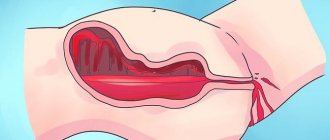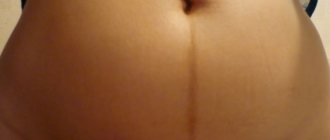Regardless of how the birth occurred (through surgery or naturally), the inner lining (mucosa) of the uterus requires a recovery period. It takes about 5-9 weeks, if everything goes well without complications.
Discharge from the genital tract after cesarean section deserves special attention. They are usually called lochia in gynecology. They include blood cells, plasma, mucus, and dead epithelium. Many women perceive them as a kind of menstruation. However, their color palette, smell, composition, volume change throughout the postpartum period and signal whether everything is fine with the young mother’s body.
Distinctive features
Any operation, like childbirth itself, is a serious stress for the body, tired after pregnancy. Therefore, a woman needs to listen to him sensitively, feel the slightest deviations and know what discharge should be like after a cesarean section and what is considered normal. This will allow her to notice warning signs in a timely manner and receive treatment if necessary. Many sources indicate that lochia after a CS is no different from those that occur after natural childbirth. In fact, this is far from the case. Differences still exist.
- The wound surface is much more extensive after a cesarean section, so the risk of infection or inflammation of the genital organs is very high. So, during discharge after surgery, you need to especially carefully carry out all the prescribed hygiene procedures and not just once a day.
- At the very beginning, just after a cesarean section, about 5-7 days, the discharge is not only bloody, but also contains a lot of mucus, which is not observed after natural delivery.
- The normal color of the discharge after a cesarean section for several days is bright red, deep scarlet, and it is much juicier than during the natural process of childbirth.
- Contraction of the uterus and its healing after cesarean section is a longer and more protracted process, so the duration of the discharge is also different and is 1-2 weeks longer.
These differences should not frighten or worry a young mother, perhaps not yet experienced in such matters, since this is the norm for discharge after a cesarean section, which indicates that everything is in order. But in order to see that something is wrong in time, you need to know about deviations, which will first of all have to be addressed to specialists. Usually they differ little from problematic lochia after natural childbirth.
Postoperative period
After giving birth by cesarean section, a woman recovers more slowly than a woman in labor after a natural birth.
And very often young mothers are interested in how much blood flows after a cesarean section, how the uterus contracts. After all, she “doesn’t understand” that the baby was born.
First of all, the woman in labor is given medications that help the uterus contract. This will allow the uterus to release blood clots, just like after a natural birth, which are called lochia. The only difference is that complete cleansing will occur with a delay of 2-3 weeks.
The sooner a mother begins to put her baby to her breast, the better and more efficiently the uterus will contract.
Nowadays, putting a baby to the breast for the first time is possible even immediately after surgery. Milk comes in around the third day, as with normal childbirth. Feeding should be done on demand to better stimulate uterine contractions.
Deadlines
One of the most exciting questions is how long does the discharge last after a cesarean section in order to know for sure whether the recovery period is prolonged or the process is proceeding within the permitted limits. Information about normal periods will allow you to control your actual menstrual cycle, which should soon improve.
Norm
The normal discharge period after cesarean section is from 7 to 9 weeks. So discharge 2 months after cesarean does not pose any danger to the health of the young mother.
Deviations
If after a cesarean delivery the discharge ends too quickly (within 6 weeks) or is very prolonged (up to 10 weeks), this is not yet a reason to panic. Yes, the norms are no longer met, but these indicators can only be determined by the individual characteristics of the body. If the composition, smell, thickness, color, and number of lochia do not indicate complications, there is no need to worry. Although even in this situation, it wouldn’t hurt to tell the doctor about it.
Pathologies
Seeing a doctor is mandatory if the duration of discharge in the postpartum period after cesarean section is beyond the normal range. This is either too quick an end (less than 5 weeks) or too long a process (over 10 weeks). Both are equally dangerous. In the first case, the remnants of the dead endometrium for some reason could not come out and there is a high probability of them festering. If lochia lasts too long, endometritis or an infectious process in the abdominal cavity or genitals can be diagnosed. A condition when the discharge after a cesarean section ends and begins again is also dangerous: this also indicates some deviations in the process of restoration of the uterus.
Knowing how long the discharge lasts after a cesarean section during the normal healing process, a woman does not have to worry that this period is very long or, on the contrary, has passed too quickly. After all, in both cases, you will have to take appropriate measures: go to see a doctor, undergo additional examinations and, if diseases or complications are detected, undergo a course of treatment, no matter how much you would like it.
Be careful . You should not be happy if your discharge has already stopped a month after a cesarean section. Such a rapid process very often ends in inflammation or infection, which requires surgical cleaning of the uterus.
How many days does the discharge last?
The answer to this question directly depends on the general condition of the mother in labor and the degree of complications received during the birth process. But, based on the diagram described above, we can approximately guess their duration. The physiological time frame for uterine contraction, scarring of sutures and renewal of mucous membranes ranges from 7 to 9 weeks.
If the rejection of spotting physiological fluids lasts longer than the established norm of 2 months, but there are no putrefactive changes, a pungent odor or burning sensation, and ultrasound showed no abnormalities, then we can talk about a significant drop in hemoglobin levels both after pregnancy and as a result of the difficult stage of recovery after cesarean section.
Most often, such a pathology is observed in women who combine the recovery process and breastfeeding. In this case, it is necessary to immediately seek help from specialists to prevent the development of anemia.
Find out when your period will start after a cesarean section while breastfeeding and bottle-fed.
There is no reason to be happy if the process is completed much faster than the deadline. The fact is that such a phenomenon indicates the development of pathological processes in the uterus and requires immediate medical intervention.
The duration of the discharge, as well as its color and consistency, allow the specialist to diagnose the recovery process after cesarean section and possible deviations from the physiological norm.
The reason for the lack of bleeding after a cesarean section is a bend or spasm of the cervix. Such a pathology is fraught with the accumulation of rejected fluids in the uterine cavities, which, during the process of stagnation, begin to fester. When diagnosing such phenomena, you must immediately contact a specialist!
If the end of discharge occurred earlier than 5 weeks after surgery, then this phenomenon indicates insufficient contraction of the uterine muscle. Such a pathology can lead to the retention of rejected particles inside the body and start the process of decay. Based on the individual characteristics of the postpartum period, the doctor may recommend that the woman in labor go for a cleanse.
Long-term lochia
When discharge after a cesarean section does not lose intensity for 10 weeks or more, such a process may indicate the onset of internal bleeding or the development of endometritis.
Depending on the duration of the inflammatory process, surgical cleansing under the guise of powerful antibiotics may be required.
It happens that there is a sudden cessation of discharge after a cesarean section, followed by a resumption. Among possible pathologies, this is the most common. This phenomenon is associated with insufficient contraction of the cervix and, with timely contact with a specialist, will not require repeated surgical intervention.
You can increase muscle contractility with the help of a special massage and oxytocin injections.
Lochia is a discharge that occurs from the vagina after childbirth. Immediately after the operation, lochia is released quite abundantly. The bloody clots are deep in color and may be most abundant if the woman is feeding her baby her own milk. The fact is that when a baby sucks milk, a lot of oxytocin is released in the body, which promotes intense contractions of the uterus.
After surgical delivery, the duration of discharge can be from 4 to 6 weeks. This period is enough for the body to completely return to normal. The only exception in this case may be complications during surgery:
- damage to adjacent organs;
- retention of parts of the placenta.
All this leads to the development of uterine bleeding. In these situations, the discharge may last much longer.
When there are no complications, the first seven days of the postpartum period include heavy bleeding with clots. Gradually, the rejection passes, and the discharge becomes smearing and has a thick consistency. This condition can last for several weeks, especially if the baby is not breastfed. As a rule, a mother who feeds her baby with her milk recovers faster after a cesarean section.
Characteristics of normal lochia:
- abundant in the first days;
- a gradual decrease in the volume of discharge in the postpartum period;
- no unpleasant odor;
- without admixtures of pus;
- without unpleasant sensations (itching, burning, severe pain);
- occur against the background of normal body temperature.
| Number of weeks | Nature of the discharge | Color |
| First week after cesarean section. | Copious discharge. | Bright scarlet color with clots. |
| Beginning of the third week after surgery. | Moderate, mucous-bloody. | Red-brown or pale pink color. |
| Fourth or fifth week after surgery. | Scanty spotting lochia. | Dark brown color. |
It is important to know: after a caesarean section, all women are necessarily transferred to intensive care, where they are observed for 24 hours. Not only pressure or temperature is checked, but also the nature and amount of bleeding from the vagina. Such observation allows timely identification of possible complications after surgery (including uterine hypotension, infection, etc.).
Unlike normal labor, after surgical removal of the fetus, the uterus needs additional artificial stimulation for full contraction. Usually special medications are prescribed for this.
Deviations from the norm
Women's discharge sometimes lasts less or longer than the normative period. The reasons for the pronounced intensity of lochia after childbirth or cesarean section completely depend on the contractile activity of the uterus. If the woman in labor is healthy and deviations from the norm are observed, then you should be wary and find out the cause of the failure.
- Abrupt ending or low volume of discharge
If the lochia was intense, but suddenly stopped, then you should immediately make an appointment with a specialist. This situation may mean: the uterus is filled with blood clots, which prevents it from fully contracting. Delayed contact with a gynecologist and refusal of therapy can lead to endometritis.
- Longer than usual or large volume of discharge
Heavy discharge, the duration of which exceeds 6-8 weeks after birth, deserves the close attention of specialists. In this case, it is better to call an ambulance. Heavy discharge exceeding the norm may mean the development of hypotonic bleeding. The cause of heavy and prolonged discharge can also be retention of parts of the placenta.
Important to know: Frequently changing a sanitary pad (more than once an hour) means bleeding. Urgent medical attention is needed.
Alarming symptoms:
- very weak or very intense and prolonged discharge (not on time);
- sudden cessation of discharge;
- a sharp increase in discharge;
- severe pain in the lower abdomen;
- the appearance of an unpleasant odor (rotten fish, etc.);
- impurities of pus in the discharge;
- the appearance of watery transparent discharge;
- detection of blood impurities in urine and feces;;
- the occurrence of itching, burning and other discomfort (a sign of thrush, bacterial vaginosis or other infections);
- increase in body temperature.
If any of these symptoms appear, you should consult a doctor as soon as possible.
Lochia character
Throughout the recovery period after surgery, the nature of lochia will change. Initially, blood clots will be released, since the uterus at this time is a large, open, bleeding wound. But over time, during the healing process, they will change to mucus, dead epithelial cells and other postpartum debris.
This also needs to be monitored very carefully. If, for example, bleeding after a cesarean section does not end, this will be an alarming signal that the damaged tissues for some reason cannot regenerate. Such cases require medical intervention and treatment. Therefore, monitor the nature of your lochia and its duration.
- Presence of blood
At first, the presence of blood in the lochia should not raise doubts among young mothers: this is the healing of broken blood vessels and damaged tissue. However, the important point here is precisely the timing, how many days does the bleeding last after a cesarean section: if more than 7-8, then this is already abnormal and you need to sound the alarm.
- Presence of clots
This is also quite understandable during this period of time: they are cells of the already dead endometrium and placenta. After 7-8 days they will go away, so the discharge will become more liquid.
- Mucus discharge
If in addition to the bloody discharge there is also mucous discharge in the first days after a cesarean section, this is also the norm: in this way the body is cleansed of the products of the baby’s intrauterine vital activity.
- Pink discharge
If pink discharge begins a month after a cesarean section, it means that the healing process is not yet complete. Perhaps, under some mechanical influence, the wounded tissues were damaged again. Very often this happens if a couple is impatient and, without waiting for the end of the recovery period, they begin to have sex too early.
- Brown shade
After 6-7 weeks, the nature of the lochia will resemble ordinary menstrual smears of a brownish color: the blood will coagulate and will no longer be so bright and scarlet.
- Purulent discharge
The danger after cesarean section is represented by purulent discharge, which is the first symptom of the endometrium (inflammation of the uterine mucosa). They are usually yellowish-green in color, smell very unpleasant and are accompanied by fever (due to infection), pain in the abdomen and perineum.
- Watery lochia
A young mother should also be alerted to watery lochia, devoid of any shade, almost transparent. This can result in the release of transudate, a fluid contained in blood or lymphatic vessels. This is bad, as it indicates poor circulation in this area. In addition, watery discharge after cesarean section with an unpleasant odor reminiscent of rotten fish is a symptom characteristic of vaginal dysbiosis (gardnerellosis).
If you had to give birth by cesarean section, you must definitely monitor the nature of the discharge that begins. It is the impurities in their composition that may indicate a particular disease that will need to be identified and treated. Often all this threatens the hospital walls again - and this is precisely at the moment when the mother so needs her baby. It is much easier to prevent the problem and enjoy unforgettable moments of communication with the baby. In addition to character, the color of the discharge can tell a lot.
Menstruation after caesarean section
Restoration of menstrual function after childbirth, regardless of the method of delivery, occurs individually for each woman. The body of a young mother produces the hormone prolactin, which stimulates the production of breast milk and blocks the maturation of follicles in the ovaries, that is, it inhibits the possible onset of the next pregnancy.
Information If a child is breastfed, then the mother has no menstruation for the first 5–6 months. Further, as complementary foods are introduced and the intensity of breastfeeding decreases, periods can appear at any time. At the beginning they may not be regular, but you shouldn’t be afraid of this. Sometimes menstruation appears only after the baby is completely weaned.
If for some reason the mother does not have milk or breastfeeding is impossible, then the first menstruation appears 2 to 3 months after birth.
Additionally, you can begin sexual activity no earlier than 8 weeks after birth. Before this, it is advisable to visit your obstetrician-gynecologist, make sure that everything has healed well and discuss the method of contraception. You can plan a new pregnancy after a cesarean section no earlier than 2–3 years later.
Hue
Normally, the color of lochia after a cesarean section should be red at first, followed by brown discharge (towards the end). The rest of the color palette should alert the young mother and force her to go to the hospital for an additional examination to find out if everything is in order with the restoration of her body.
Yellowness
If yellow discharge begins after a cesarean section, it may indicate the following postpartum processes:
- pale yellow, scanty lochia by the end of 2-3 weeks is normal;
- bright yellow, almost orange discharge with a greenish tint, putrefactive odor on days 4-6 - a symptom of pronounced, but just beginning endometritis;
- copious, mucous, yellow discharge after 2 weeks is a sign of already hidden and, most likely, rather advanced endometritis.
Endometritis cannot be treated on its own: antibiotic therapy or even surgery will be required.
Greenery
It is not difficult to guess that the green discharge that began after a cesarean section is explained by the presence of pus in it. It indicates the occurrence of an infectious, inflammatory process in the uterus. Only a medical examination will help determine its cause and diagnose the disease.
White lochia
By itself, without accompanying symptoms, white discharge, which may begin some time after a cesarean section, does not pose a threat. But as soon as certain signs appear, you need to be alert. These include:
- itching of the perineum;
- redness in the intimate area;
- if there is discharge with a sour smell;
- cheesy consistency.
In such cases, a bacterial culture or vaginal smear is required for an accurate diagnosis and appropriate treatment.
Black
If after a cesarean section there is black discharge without odor or pain, it should be taken as normal. They are dictated by hormonal changes in the blood after childbirth. A deviation is if they occur some time after the operation.
To avoid complications of the recovery period after cesarean section, you need to monitor the color of postpartum discharge. She can suggest a problem at the very beginning. This will make it easier to eliminate it and allow you to quickly return to normal after completing the necessary course of treatment.
Quantity
A young mother also needs to pay attention to how much lochia comes out of her in order to judge how the body’s recovery is proceeding. If after a cesarean section there is little discharge, especially in the very first days, this may be an alarming signal that the tubes, uterine ducts are clogged, a blood clot has formed, etc.
The opposite situation is no less dangerous: profuse lochia that does not stop for too long is an alarming signal about the impossibility of full restoration of the uterus after surgery. In both cases, you need to undergo a special examination and find out what is the reason for such deviations.
Any woman wants postpartum lochia to end as soon as possible and nothing to overshadow happy motherhood. However, there is no need to be too hostile towards them. It is they that can serve as that alarming and sometimes the only signal that not everything is in order with the restoration of the body and some measures need to be taken to help it. You should especially be wary of discharge after a cesarean section with an odor and an unrealistically bright hue. This almost always ends with a course of antibiotic treatment, which is highly undesirable during lactation, or another surgical intervention.
source: www.vse-pro-detey.ru
Caesarean section, as a method of delivery, sometimes becomes the only possible one. But after it, the restoration of the female body has its own nuances. Its important criteria are discharge after cesarean section, how long it lasts, and what it looks like. The woman who has undergone the intervention should know this.
Types of discharge after surgery
Many are sure that the release of the uterus from the remains of unnecessary tissue after a cesarean section proceeds in the same way as during a normal birth. But this is not entirely true. During the operation, the organ was dissected and then stitched. There is a scar on the uterus that needs to heal. That is, the damaged surface is larger, which means that tissue regeneration will take longer. And the nature of the discharge is somewhat different:
- At the initial stage (5 - 7 days), a lot of mucus is noticed in the lochia. This is not the case after natural delivery. The color of the discharge is intense red due to a significant amount of blood and is richer than in the absence of surgical intervention.
- Clots are definitely present. They are evidence that the uterus is freeing itself from the placental particles remaining in it. But 7 - 9 days after the intervention there are fewer of them, and the discharge has a more uniform consistency.
- After 6 - 7 weeks, their shade changes to brown, since the inner lining of the uterus has been restored for the most part. The organ contracts less intensely; the contents have time to coagulate before leaving the cavity.
What else does it happen at different times from the completion of the operation:
- Heavy discharge (250 - 300 ml of fluid per day) cannot, if everything goes well, appear for longer than 3 - 4 days. But this time the young mother is usually still in the maternity hospital.
- They become more modest in volume, with less blood present and not so bright red from days 4 to 10.
- From the 11th day their color becomes lighter. The volume is decreasing.
- On the 21st day after cesarean delivery, the discharge becomes more noticeable. And there is less blood in them.
Lochia after a cesarean section lasts longer than in those who gave birth without the help of a surgeon. This is due to the healing of the suture, difficulties, the likelihood of which is also higher.
Normally, they do not last longer than 7 - 9 weeks. During this period, the uterus manages to cleanse itself of the consequences of the existence of the fetus in it and restore the mucous membrane.
During the first 7 days this occurs especially intensively, which is reflected in the number of lochia. A woman will have to use a new pad every 2 hours.
There is no reason to rejoice if the process is completed early. This does not indicate an imminent recovery, but rather the emergence of more than trivial problems. However, the individual physiological characteristics of some mothers make it possible to complete the removal of secretions earlier even in full health. But this happens rarely, and the absence of danger must be confirmed by a specialist.
We recommend reading the article about uterine restoration after cesarean section. From it you will learn about the postpartum state of the organ and its recovery after surgery, features of the postoperative period, and possible complications.
When is it time to panic
How much discharge there is after a cesarean section is an important criterion in assessing the gynecological well-being of a young mother. It is important to keep under control not only the timing, but also the appearance of the contents of the uterus. There are differences in the discharge at each stage of recovery.
| Symptom | Causes |
| At 4 - 6 days after birth, bright yellow inclusions were found in the discharge | This happens with acute endometritis. When this is noticed after 2 weeks, the pathology is sluggish, but already developed. |
| The volume of discharge apparently decreased in the first week after delivery | This may be a sign of premature narrowing of the cervical canal, which prevents their exit. The same thing happens when uterine contractions weaken. The pathology, in addition to a sharp decrease in the volume of fluid with blood, is manifested by an increase in abdominal pain. The temperature may rise and severe weakness may occur. The same is suspected if cleansing of the organ is stopped too quickly (up to 7 weeks after surgery). |
| The volume of discharge does not decrease over time | Bleeding after a cesarean section occurs if there are membranes left in the uterus, the organ contracts weakly, or there are problems with blood clotting. Another circumstance that can cause intense discharge, when its nature should already change, is the divergence of the internal seam. This is possible if the operation was not performed well enough, the woman began to carry weights too early or was in a hurry to resume intimate life. |
| The discharge abruptly stopped prematurely, but then resumed again | This sign indicates the existence of an obstacle to their removal. How long the discharge lasts after a cesarean section can be “decided” by a polyp that grows after childbirth, or stenosis of the cervical canal. Simultaneously with their disappearance, discomfort occurs, then abdominal pain and fever. The resumption of the cleansing process is complemented by a putrid odor and a change in the color of the mucus. |
| Discharge continues for longer than 9 weeks | As in all previous cases, an examination is necessary, since there are many reasons causing the problem. This is a hormonal disorder, emerging pathology, uterine atony and internal suture dehiscence. |
It is unacceptable to tolerate severe abdominal pain. Discomfort is present for a long time, but it should decrease, not increase. The same applies to the color and smell of the contents of the uterus. Greens and water at the early recovery stage will require the intervention of a doctor.
How long the discharge lasts after a cesarean section is determined by many factors. This is the weight of the baby, the volume of amniotic fluid, existing diseases, the number of births in the past, the presence or absence of lactation. But in many ways, healthy recovery, that is, the duration of discharge, depends on the efforts made. You need to start moving slowly early, regularly lie down on your stomach, but not overwork. And of course, if you have the slightest doubt about the correctness of rehabilitation, do not delay consulting a doctor.
source: 7mam.ru
Regardless of whether the birth turned out to be natural or surgical, the inner lining of the reproductive organ needs time to recover. On average, it lasts 5-9 weeks, unless complications arise. Particular attention is paid to discharge after cesarean section. In obstetrics they are called lochia.
Lochia includes blood, rejected epithelial particles and mucus. There are no fundamental differences between the discharge that occurs after a physiological birth and those that appear after a cesarean section. Most women treat them like menstrual bleeding. By indicators such as the smell, color and volume of discharge after a cesarean section, you can judge whether everything is all right with the new mother.
Normal discharge after cesarean section - what does it look like and how long does it last?
In the early postoperative period, discharge after cesarean section can be easily compared with normal heavy menstruation - the lochia is colored red and contains individual clots.
In the first 7 days after surgery, their total volume can reach 500 ml; normally, a sanitary pad should be filled no faster than 2 hours. Every day the doctor checks with the woman the number of lochia and their color.
Discharge after cesarean section increases with physical activity, breastfeeding, and palpation of the abdomen. As a result of these actions, the natural contractile activity of the uterus is stimulated, due to which its contents are more effectively expelled.
From the 2nd week, the lochia begins to darken, acquiring a brownish tint. Their volume gradually decreases. By the end of the 5th week, blood discharge after a cesarean section should normally become spotty, weak and acquire a lighter shade.
At the 8th week, the process of restoration of the inner layer of the reproductive organ is almost completely completed. Thus, the discharge after a cesarean section becomes light after 2 months, just like before pregnancy. At this time, the woman is recommended to visit a gynecologist for an appropriate examination and selection of a contraceptive method.
The nature and intensity of lochia is influenced by contractions of the uterine myometrium. After a birth performed by cesarean section, this process is worse than after a natural one, since part of the muscle fibers are damaged as a result of the surgical incision.
To improve the contractile activity of the uterus and prevent the development of postpartum hemorrhage, immediately after the operation the woman is started to be administered the drug Oxytocin according to the scheme, and it is also strongly recommended to establish natural feeding to enhance the synthesis of oxytocin by the body.
Features of discharge that women encounter after cesarean section, their types and timing
After such a complex operation, it is important for every woman to know what normal discharge after a cesarean section can and should be like and how long it will last. In the first postpartum week, they are red in color and very similar to menstrual blood, which includes clots, but differ in that they are quite abundant. The volume of such bleeding after a caesarean section often reaches 500 ml; the sanitary pad fills up too quickly and requires replacement every hour and a half. The intensity of blood flow directly depends on how quickly and well the uterus contracts; it intensifies when walking or palpating the abdomen. The released blood smells unpleasant, which is normal in the first days after childbirth. But if the lochia smells rotten, this indicates the development of an infectious process and inflammation, which requires urgent examination and prescription of medications.
In the second postpartum week, the discharge becomes less intense, its decrease is noticeable every day, and the color changes from bright red to red-brown.
After four to five weeks, the discharge becomes small and is distinguished by its spotting nature and dark brown color. Then they gradually lighten, gradually become yellow, and by the time the uterus and its mucous membrane are restored, they become exactly the same as those observed in the woman before pregnancy.
The moment when the discharge becomes discolored is considered the end of the postpartum period, the endometrium of the uterus has regenerated and the young mother can completely take care of her baby without worrying about anything.
How much discharge occurs after a caesarean section depends on the individual ability of the female body, in particular the uterus, to contract. In general, the process can take six to eight weeks. After recovery, regular periods do not occur while the woman is actively breastfeeding; a decrease in lactation and the transition to feeding the baby will lead to the start of the menstrual cycle at any time.
Personal hygiene after cesarean
Personal hygiene after surgical delivery has its own nuances:
- Sanitary pads are changed as needed, but at least every 3 hours.
- The use of tampons during the postpartum period is strictly prohibited, since their use can cause the development of an infectious process.
- After each visit to the toilet, a woman should wash her genitals with clean water.
- You cannot douche or take a bath until the end of the recovery period, only take a shower.
Several recommendations for hygienic care after cesarean
After childbirth, it is especially important to follow several recommendations for hygienic care:
- the sanitary pad should be changed every three hours, regardless of the degree of contamination;
- tampons are strictly prohibited (their introduction contributes to the retention and proliferation of microbes in the uterus);
- you can’t douche;
- You can take a bath only after the end of the postpartum period;
- At first, you should not get the seam on your stomach wet (keep it clean with a damp towel);
Sexual activity is permitted two months after childbirth, only after a complete postpartum period not complicated by infections. Before this, a woman who has had a caesarean section is recommended to visit a gynecologist.
In what cases should you consult a doctor?
Every woman who has become a mother through surgery should be informed about how long the discharge lasts after a cesarean section. The cessation of lochia too early, as well as prolonged cessation, can be a bad sign.
But doctors insist that it is not so much the time frame that is important, but the composition, color, smell and total number of lochia. If the nature of the discharge is normal, then there is nothing to worry about. And how long the discharge lasts after a cesarean section depends almost entirely on the specific characteristics of the body. But even in this situation, you should consult a doctor.
It is imperative to inform a specialist if lochia ends too early - less than 5 weeks, or too late - continues 10 or more weeks after birth. Both of these conditions pose serious risks.
In the first situation, the uterus may not have been completely cleansed and blood, mucus and remnants of the epithelium remain in it, which often ends in a serious inflammatory process. This should be indicated by discharge after a caesarean section with an odor. Read more about why the uterus contracts poorly after childbirth→
Prolonged lochia is also the result of an infectious process - endometritis. There is also a danger when the discharge either ends or increases again: such a case also does not fit into the norm.
Yellow discharge after cesarean section without the presence of a foreign odor is normal only at the end of the first 3 weeks after birth. But if they continue after this time, they are considered a sign of pathology - an advanced form of endometritis, which must be treated under the supervision of a doctor.
Purulent discharge after cesarean section colored green indicates the presence of an acute infectious pathology in the uterus.
White discharge from the genital tract is not dangerous until it is accompanied by symptoms such as redness and itching in the intimate area, discharge with a sour odor and a cheesy consistency. Most likely, we are talking about vaginal candidiasis - a frequent companion to antibacterial therapy, which is necessarily prescribed after surgical delivery. But only a specialist can give an accurate diagnosis.
By observing how long the discharge is after a cesarean section, assessing its nature, the young mother will understand whether her postpartum recovery stage is being delayed or everything is fine. If deviations from the norm occur, do not hesitate to consult a doctor. The examination and course of treatment that you will have to undergo if necessary are trifles compared to the complications that can arise if you let the situation take its course.
What else should you pay attention to?
A woman should be concerned not only about the changed nature of postpartum discharge, but also about such alarming signs as abdominal pain and fever. But the last symptom may also be a variant of the norm if the young mother has not yet established lactation and the first pronounced flow of milk is observed.
Sometimes, due to insufficient care or infection, a woman in the postpartum period develops discharge from the suture after a cesarean section.
This pathology is characterized by the following symptoms: hyperemia, fever, swelling and sanguineous or purulent discharge from the suture after cesarean section. If you do not notice this complication in time or self-medicate, the suture will fester and the young mother will need surgical help.
Typically, every woman who has become a mother by cesarean section visits a specialist 2 months after the birth of the baby. During this time, it becomes known how the recovery process is proceeding and whether there are any complications. But the woman will have to monitor whether postpartum discharge is normal on her own in order to seek medical help in time.
Author: Olga Rogozhkina, doctor, especially for Mama66.ru
Causes for concern
If there are any changes in the volume or nature of the discharge, you should definitely seek medical help in the following cases:
- The smell of the discharge changed and became pungent and purulent
. This most often indicates the occurrence of endometritis - inflammation of the inner surface of the uterus. Body temperature rises, abdominal pain intensifies, and general health worsens. After a caesarean section, endometritis develops more often than after a natural birth. - The volume of bloody things has increased sharply or their number does not decrease for a long time
- this indicates the development of late hypotonic bleeding.
After a cesarean section, they occur more often, since due to the presence of a suture on the uterus, it cannot contract completely well. If there is heavy bleeding (more than one pad per hour), you should urgently
call an ambulance. - The discharge suddenly stopped
- the outflow of lochia from the uterine cavity was disrupted. This may be caused by a backward bending of the uterus. If their stagnation is not prevented, endometritis may develop. - Curdled discharge and itching in the vagina
indicate the presence of candidiasis colpitis (thrush). The risk of its development is associated with taking antibiotics after surgical delivery.









